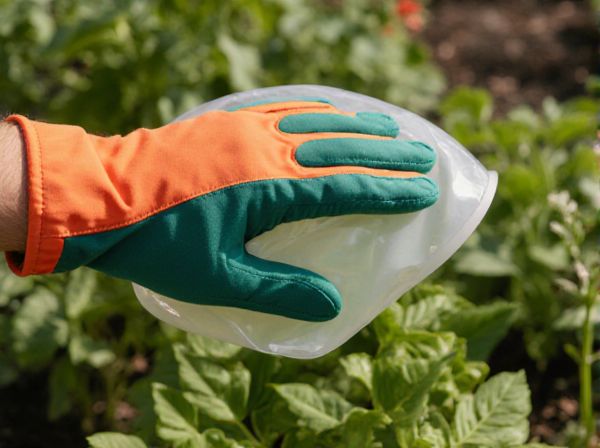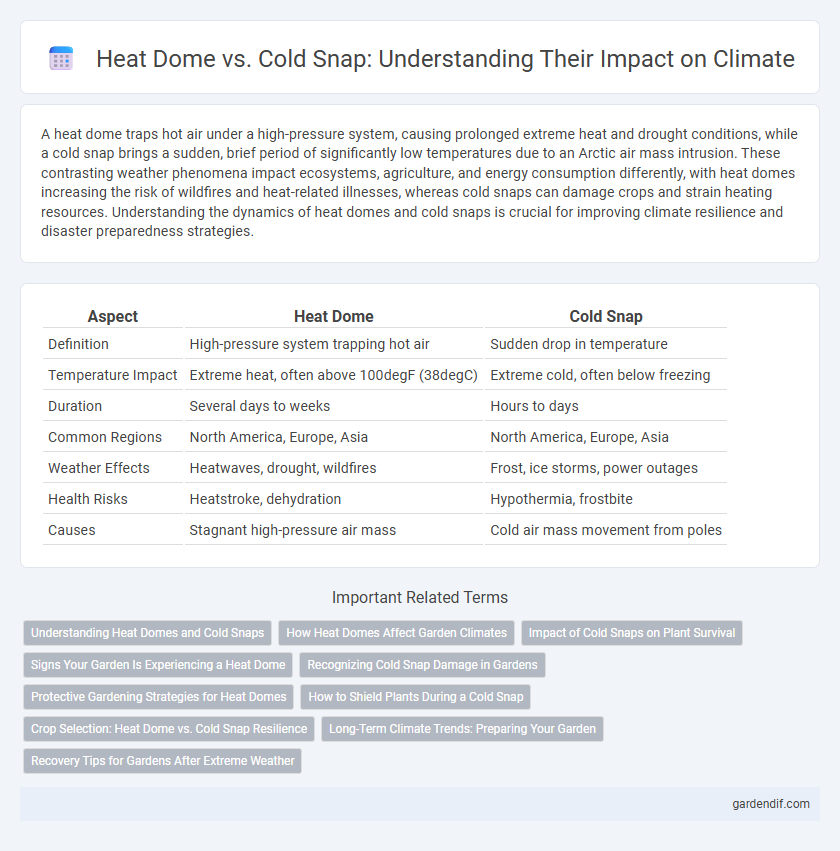
Heat Dome vs Cold Snap Illustration
A heat dome traps hot air under a high-pressure system, causing prolonged extreme heat and drought conditions, while a cold snap brings a sudden, brief period of significantly low temperatures due to an Arctic air mass intrusion. These contrasting weather phenomena impact ecosystems, agriculture, and energy consumption differently, with heat domes increasing the risk of wildfires and heat-related illnesses, whereas cold snaps can damage crops and strain heating resources. Understanding the dynamics of heat domes and cold snaps is crucial for improving climate resilience and disaster preparedness strategies.
Table of Comparison
| Aspect | Heat Dome | Cold Snap |
|---|---|---|
| Definition | High-pressure system trapping hot air | Sudden drop in temperature |
| Temperature Impact | Extreme heat, often above 100degF (38degC) | Extreme cold, often below freezing |
| Duration | Several days to weeks | Hours to days |
| Common Regions | North America, Europe, Asia | North America, Europe, Asia |
| Weather Effects | Heatwaves, drought, wildfires | Frost, ice storms, power outages |
| Health Risks | Heatstroke, dehydration | Hypothermia, frostbite |
| Causes | Stagnant high-pressure air mass | Cold air mass movement from poles |
Understanding Heat Domes and Cold Snaps
Heat domes occur when high-pressure systems trap warm air in a region, causing temperatures to soar well above average for extended periods. Cold snaps result from sudden invasions of polar air masses, leading to rapid and intense drops in temperature that can disrupt ecosystems and infrastructure. Understanding the dynamics of heat domes and cold snaps helps in forecasting extreme weather events and mitigating their impacts on public health and energy demand.
How Heat Domes Affect Garden Climates
Heat domes create prolonged periods of high temperatures by trapping warm air under a high-pressure system, significantly stressing garden plants through increased evaporation and soil moisture loss. These intense heat conditions can lead to wilting, reduced growth, and increased water demand in gardens, often requiring frequent irrigation to maintain plant health. Unlike cold snaps that cause frost damage, heat domes primarily challenge gardeners with extreme heat stress and drought-like conditions affecting plant vitality and soil quality.
Impact of Cold Snaps on Plant Survival
Cold snaps cause rapid temperature drops that lead to frost damage in plants, disrupting cellular function and water transport. Prolonged exposure to freezing temperatures can kill sensitive vegetation and reduce crop yields significantly. Unlike heat domes that induce heat stress, cold snaps freeze plant tissues, often resulting in irreversible injury or plant death.
Signs Your Garden Is Experiencing a Heat Dome
Wilting leaves, scorched foliage, and dry, cracked soil are clear signs your garden is experiencing a heat dome. Prolonged exposure to intense heat can cause plants to suffer from heat stress, reducing their ability to photosynthesize effectively. Monitoring soil moisture and providing shade during peak temperatures helps mitigate damage and supports plant recovery.
Recognizing Cold Snap Damage in Gardens
Cold snap damage in gardens often manifests as wilted or blackened leaves, brittle stems, and stunted growth caused by frostbite or sudden temperature drops. Unlike heat dome effects that cause heat stress and dehydration, cold snaps can lead to cell damage in plant tissues and increased susceptibility to fungal infections. Early recognition through monitoring frost patterns and protecting sensitive plants with covers or mulches is essential to minimize long-term garden damage.
Protective Gardening Strategies for Heat Domes
Heat domes create prolonged periods of extreme heat that stress plants, requiring protective gardening strategies such as mulching to retain soil moisture and shading to prevent leaf scorch. Using drought-resistant plant varieties and implementing efficient irrigation systems can help maintain plant health during these intense heat events. Raised beds and windbreaks also improve air circulation and reduce heat exposure, enhancing plant resilience under heat dome conditions.
How to Shield Plants During a Cold Snap
Protecting plants during a cold snap requires targeted insulation techniques, such as covering delicate foliage with frost cloths or burlap to trap heat and prevent frost damage. Using mulch around the base of plants helps retain soil warmth, while portable heaters or heat lamps can create localized warmth in greenhouses or garden spaces. Monitoring local temperature forecasts and watering plants adequately before a freeze enhances resilience by maintaining soil moisture and promoting root health.
Crop Selection: Heat Dome vs. Cold Snap Resilience
Heat dome conditions demand selecting heat-tolerant crops such as sorghum, millet, and certain drought-resistant maize varieties, which maintain productivity during prolonged high temperatures. Cold snap resilience favors hardy crops like winter wheat, barley, and rye, capable of withstanding sudden frost and freezing temperatures without significant yield loss. Understanding crop-specific tolerance levels to extreme heat or cold events is crucial for optimizing agricultural output under climate variability.
Long-Term Climate Trends: Preparing Your Garden
Heat domes cause prolonged periods of intense heat, stressing plants and depleting soil moisture, while cold snaps bring sudden temperature drops that can damage sensitive foliage and delay growth. Understanding regional climate trends helps gardeners select heat-tolerant species or frost-resistant varieties to improve resilience. Soil health management and efficient irrigation strategies are critical for mitigating impacts of extreme temperature fluctuations over time.
Recovery Tips for Gardens After Extreme Weather
After a heat dome, gardens benefit from deep, infrequent watering to restore soil moisture and reduce plant stress. In the aftermath of a cold snap, protect tender plants by mulching to insulate roots and pruning damaged foliage to encourage healthy regrowth. Monitoring soil conditions and adjusting feeding schedules help optimize recovery and promote resilient garden growth.
Heat Dome vs Cold Snap Infographic

 gardendif.com
gardendif.com